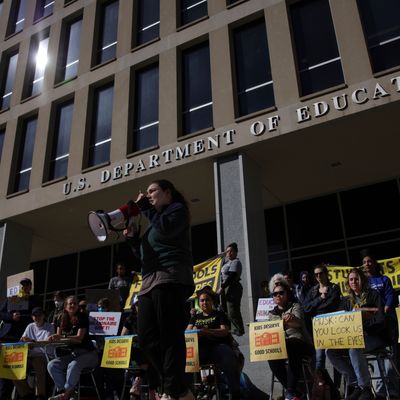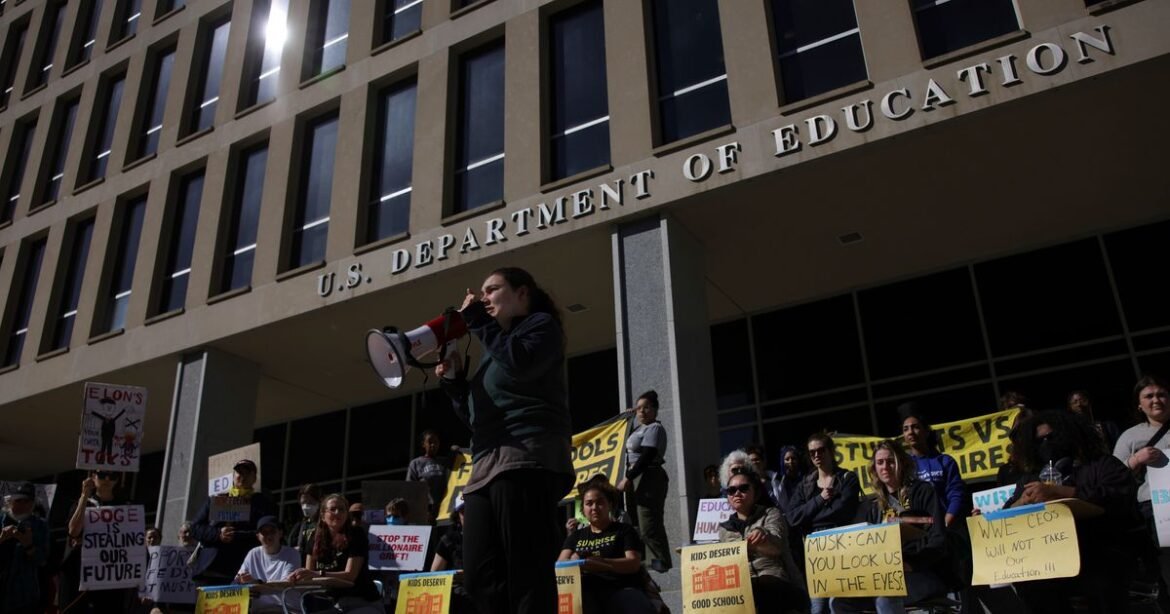
The administration’s determination to shutter, not improve, the Education Department has never been in doubt.
Photo: Bryan Dozier/NurPhoto/AP Photo
Just last week, the Supreme Court, in one of its increasingly notorious “shadow docket” orders, which provide the Trump administration relief from pesky lower-court judges, removed restraints on Team Trump’s ability to implement mass firings in disfavored parts of the federal government. At first blush, a new July 14 order seems quite similar: The administration also initiated a “reduction in force” at the U.S. Department of Education, and the lower courts ordered that the action be stopped until questions about its legality could be addressed. Once again, the Supreme Court (in this case, just the six conservative justices) set aside the hold and let the administration proceed with mass firings, this time until questions over the standing to sue of the states, school districts, and unions who succeeded in obtaining the lower-court actions are resolved.
What makes this latest order exceptional and alarming, though, is that in the Department of Education case, the administration didn’t even pretend to be pursuing the efficiency or internal-reorganization goals for which RIFs might be justified. It was, instead, blatantly seeking to shutter a Cabinet-level department authorized by Congress and given a variety of congressionally mandated responsibilities. The intention to kill the department was extensively advertised on the 2024 campaign trail. It was reaffirmed when the department’s intended undertaker, Linda McMahon, was nominated as Secretary of Education. And then it was formalized by Trump in a March 20 executive order with a rather clear Section 2 headline: “Closing the Department of Education and Returning Authority to the States.” And indeed, on applying to the Supreme Court for a green light, the administration didn’t even make an argument on the merits: It questioned the standing of the plaintiffs, and that was enough for yet another unsigned order giving Trump what he wanted.
It’s noteworthy that the dissent to this order (joined by the other two liberal justices, Elena Kagan and Ketanji Brown Jackson) was written by Justice Sonia Sotomayor, who concurred with the earlier RIF green light on the very specific grounds that Trump had promised to obey the law in carrying out the mass firings and needed to be given the opportunity to do just that (though the odds of compliance were extremely low). This time around, the lawlessness was loud and proud:
The President … lacks unilateral authority to close a Cabinet-level agency. Congress created the Department, and only Congress can abolish it. The President, too, may not refuse to carry out statutorily mandated functions assigned to the Department, for he must “take Care that the Laws be faithfully executed.” Art. II, §3.
Rather than contest these bedrock principles, the Government below contended that the mass terminations were not part of any planned closure, but instead simply intended to “cut bureaucratic bloat …” The record unambiguously refutes that account.
Sotomayor then goes on to cite the chain of events from Trump’s campaign rallies to McMahon’s RIFs. Precisely because the administration was abusing the RIF authority to shut down an array of federal programs affecting the states, school districts, and education employees, Sotomayor suggested, these plaintiffs likely had standing, the administration had no business asking the courts to dismiss their suits, and the Supreme Court had no business clearing a path for this lawlessness:
The President must take care that the laws are faithfully executed, not set out to dismantle them. That basic rules undergirds our Constitution’s separation of powers. Yet today, the majority rewards clear defiance of that principle with emergency relief.
As Georgetown legal scholar Steve Vladeck notes, this abuse of emergency-relief powers via the so-called shadow docket is now routine, and “here we are — with the seventh different completely unexplained grant of emergency relief to the Trump administration in just the last ten weeks, and yet another one that is going to have massive real-world effects long before the justices ever confront whether what the government is doing is actually lawful.”
The apparent partisanship of the conservative majority, moreover, is made evident by the wildly different disposition of this case from a very similar plea for relief made by the Biden administration in 2023 over challenges to his student-loan initiative, notes Vladeck: Then, “the Court kept a controversial Department of Education policy initiative paused for 6.5 months while it sorted out whether anyone had standing to challenge it — rebuffing the President’s request that the policy go back into place in the interim.” Seems it really matters who asks this Court for a break.
If the Supreme Court majority survives 2025 with much of a reputation left for the impartiality on which Chief Justice John Roberts prides himself, it will be amazing. If they are determined to make life easier for Trump, they could at least do so in argued cases leading to written opinions stating what they are doing and why.

